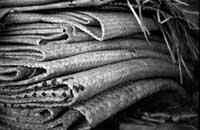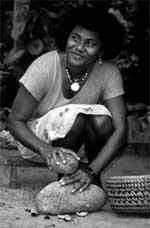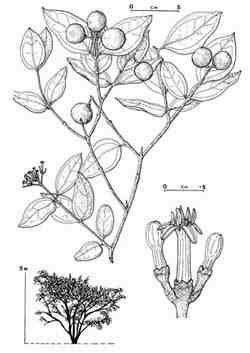Backgrounds
 |
| In the market of
Suva, Fiji, a vendor in
front of lenghts of
Pandanus leaves. |
|
Over
the next few years, the People
and Plants Initiative will be
developing activities in
Melanesia and Polynesia with
Barry Evans and other colleagues
from the WWF South Pacific
Program, based in Suva, Fiji.
During an initial visit in
November and December, I had the
opportunity to capture and borrow
the following images of plant use
in the region./GJM |
| |
|
| |
|
 |
Leaves, found
dried and bundled in the markets
of the South Pacific, belong to a
species of Pandanus
(Pandanaceae). There are about
600 species of Pandanus in the
Old World tropics, many of them
local endemics. In the South
Pacific, pandanus leaves are the
basic material for almost all
weaving. Diverse varieties and
treatments yield different
textures and colors, including
white straw, off-white, yellow
and reddish-brown. |
| Kukuvalu is a type of
pandanus which turns deep brown
when dried. Mats may bronze
through age, or by being dyed or
smoked over a fire.Simple designs
are woven with black pandanus,
which is dyed by soaking white
leaves for a few days in swamp
mud then boiling them in a liquid
beaten from the husk of green
coconut or pressed from the
leaves and bark of various trees.
Ethnobotanical information from
James, K.E. 1988. Making Mats and
Barkcloth in the Kingdom of
Tonga, a pamphlet published by
the author and distributed by the
Institute of Pacific Studies of
the University of the South
Pacific. Contact: Linda Crowl,
Publications Fellow, Institute of
Pacific Studies,University of the
South Pacific, P.O. Box 1168,
Suva, Fiji; Tel. +679.212248, Fax
+679.301594, e-mail crowl_l@usp.ac.fj |
| |
| |
 |
Textures, from a
basket woven by Maori people of
New Zealand using leaves of
Phormium tenax Forster &
Forster f. (Agavaceae). Called
bush flax in English and harakeke
in Maori, this plant is endemic
to wetlands of New Zealand. The
leaves were the principal fiber
used by the Maori for all
textiles, nets, baskets and many
other utilitarian objects. The
stripped leaves produce a strong,
silky fiber, called muka, which
is used for cloaks and other
pieces of clothing. |
| There are many cultivars
grown as ornamentals, including
one with reddish leaves; the
cultivars are named by the Maori
and used for distinct purposes.
The basket (called a kete in
Maori) that forms the background
of the Viewpoints section was
woven by Jocelyn Hartstone,
member of a New Zealand Maori
weaver’s group. The Maori
people will be hosting the 6th
International Congress of
Ethnobiology in New Zealand in
November 1998. Contact: Aroha Te
Pareake Mead, Maori Congress, PO
Box 13-177, Johnsonville,
Wellington, Aotearoa New Zealand;
Tel. +64.4.4797781, Fax
+64.4.4947106, e-mail aroham@nzonline.ac.nz |
| |
| |
 |
Seeds, in this
case, are drupes: fleshy,
indehiscent fruits that contain
one or more seeds, each
surrounded by a stony layer. The
fruits pictured here are from
Canarium indicum L.
(Burseraceae), one of more than
50 species of Canarium
distributed from West Africa to
Polynesia. Although the standard
English common name of canarium
nut is used for any nut of the
genus Canarium, each species has
diverse indigenous names. |
| Canarium indicum, for
example, is known as galip in
Papua New Guinea, ngali in the
Solomon Islands and nangai in
Vanuatu. Among edible nut trees
of the South Pacific, the genus
Canarium is considered to be of
particular economic potential
because the nuts have a delicate
almond-like taste and a hard
non-perishable shell. The trees
are widely distributed in
Melanesia and have a long history
of cultivation, which has led to
the selection of several
domesticates now recognized as
distinct species. Additional
information about canarium and
other edible nuts of the Pacific
can be found in Stevens, M.L.,
R.M. Bourke and B.R. Evans. 1996.
South Pacific Indigenous Nuts.
Canberra, Australian Centre for
International Agricultural
Research. Contact: Paul Ferrar,
ACIAR, GPO Box 1571, Canberra
City 2601, Australia; Tel.
+61.6.2170549, Fax +61.6.2170501,
e-mail ferrar@aciar.gov.au |
| |
| |
 |
Piles of Pandanus mats
for sale in the market. |
| |
|
 |
A woman from
Guadalcanal, Solomon Islands
cracking ngali nuts (Photo: Barry
Evans). |
BACK
Profile
 |
Photo:
© Andrew Pawley
|
Ian Saem Majnep
Ian Saem Majnep, a Kalam speaker, was
born about 1948 in Kaironk Valley, in the
remote southwest corner of Madang
Province, Papua New Guinea. In 1963 Saem
met the anthropologist-naturalist Ralph
Bulmer and the linguist Andrew Pawley of
the University of Auckland, who had begun
an interdisciplinary research program
among the Kalam and Kobon speaking
peoples of the Kaironk Valley. Noting
Saem’s expertise in bushcraft,
Bulmer enlisted the 15-year-old as one of
his informants and field guides. From
1968-1977 Saem worked as a technician in
the Department of Anthropology and
Sociology at the University of Papua New
Guinea in Port Moresby, assisting
researchers in various parts of Papua New
Guinea.In the 1970s Saem and Bulmer began
to collaborate on a series of writing
projects. Their acclaimed book, Birds of
My Kalam Country (1977), was edited by
Bulmer from transcripts of their
conversations. Their later works were all
written by Saem in Kalam with English
translation and commentary by Bulmer. A
short monograph, Some Food Plants in our
Kalam Forests, appeared in 1983. Before
Bulmer died of cancer in 1988, they had
drafted a work of over 800 pages of
bilingual text about Kalam knowledge and
use of wild animals. A large part of it
was published in 1990 as six working
papers, Kalam Hunting Traditions, edited
by Andrew Pawley.At present Saem is
collaborating with Pawley (assisted by
the botanist Rhys Gardner) on a book
about wild plants of the forest and
grasslands, to be called Kalam Plant
Lore. This builds on foundations laid by
Bulmer and Saem who, over 25 years, had
collected plants and information about
their contexts and use. In 1989 the
University of Papua New Guinea awarded
Saem an honorary doctorate in science.
Contact: Ian Saem Majnep, c/o Kaironk
Community School, Simbai, Madang
Province, Papua New Guinea.
Andrew
Pawley
Andrew Pawley is Professor of
Linguistics and head of the Linguistics
Department in the Research School of
Pacific and Asian Studies, Australian
National University, Canberra. He studied
anthropology and linguistics at the
University of Auckland where he received
a doctorate in 1967. His main research
interests are the description and history
of the languages and cultures of Pacific
Island peoples and the development of
models of language that allow for richer
linguistic descriptions. He has done
fieldwork in Papua New Guinea, Fiji,
Samoa and Tasmania. Since 1963 he has
been engaged in interdisciplinary
research among the Kalam of the Schrader
Ranges, Papua New Guinea, with the late
Ralph Bulmer, Saem Majnep and others,
focusing on Kalam perception and use of
the natural environment. He has also
worked since 1967 with the people of Waya
Islands, Western Fiji, on linguistic and
ethnobiological studies. Contact: Andrew
Pawley, Department of Linguistics, RSPAS,
Australian National University, Canberra,
ACT 0200, Australia; Tel. +61.6.2490028
or 2492279, e-mail apawley@coombs.anu.edu.au
BACK
What is
this . . . ?
Did you recognize
the plant scattered through these pages?
 |
It is Strychnos
lucida R. Br. (Loganiaceae), a
small tree of 5 m that has white
to gray mottled bark. Its
leathery, opposite leaves are
marked at the base with three
prominent veins. It has white
tubular flowers in terminal
cymes, and orange, beaked
globular berries of 2-4 cm
diameter. It grows in monsoon
vine thickets on sand and rocky
hills. Among other uses, the
fruits and bark are prepared as a
liniment for rheumatism, general
weakness, backache, arthritis and
painful swellings. The fruits and
wood are used for sores, boils,
scabies and other skin
conditions.The illustration and
ethnobotanical information is
taken from Traditional Aboriginal
Medicines, a book further
described under Parks and
Wildlife Commission of the
Northern Territory (this issue,
page 8). |
BACK
|